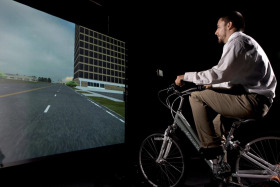- November 23rd, 2022
- 0 Comments

How do you accurately gauge what type of bicycle infrastructure treatments work best? Crash data alone is far from robust enough to get a clear picture. Video evidence can be helpful, but it’s a pain to gather and it’s not easy to create the controlled environments necessary for scientific research when you rely on real-life traffic.
That’s where an innovative lab at Oregon State University in Corvallis comes in. Researchers there have a bicycle simulator that mimics traffic conditions (which you might recall from a story we shared back in 2011). And since it’s in a lab, riders can be tracked with all sorts of helpful technology to better understand how they react to different situations.
A new study by Logan Scott-Deeter, David Hurwitz, Brendan Russo, Edward Smaglik and Sirisha Kothuri published in Accident Analysis & Prevention (Elsevier, January 2023), used the simulator to compare three popular design treatments aimed at making bicycling safer. The research team (from Oregon State, Northern Arizona, and Portland State universities) wanted to know how riders responded when they approached a mixing zone, a bicycle signal, and a bike box. They tracked stress levels, eye movements, and riding behaviors of 40 study participants to see which design is best suited to avoid collisions.













